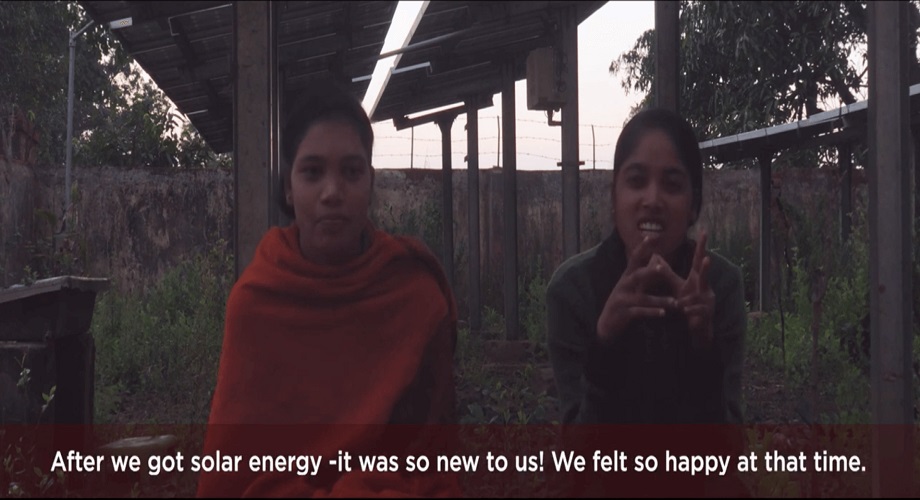Renewable energy lights up the village Maligaon after five years of darkness
FeatureBy Priya Pillai, Eshaan Patheria
20 September 2019

Tulsa Majhi mixes plaster for the construction of the powerhouse. After mixing it, she shovels it into a small metal bowl which she will carry on her head to the masons for them to use. Photograph by Ajaya Behera
Maligaon is a small village of 55 households in Thuamul Rampur block of Kalahandi district in Odisha. Gram Vikas and the people of Maligaon have been partners for over 30 years, collaborating on projects ranging from sanitation to education and solar energy.
In 2009, the village community and Gram Vikas installed a solar micro-grid. The main system components included a 9.65 kW total PV array capacity, 96 kWh tubular lead-acid battery bank and an Urja Bandhu (charge controller that makes available a fixed amount of energy daily) in every home.
However, in 2013, the solar micro-grid failed due to the death of the tubular lead acid batteries and improper maintenance. In 2014, the main grid was installed in Maligaon. However, blackouts lasted (at worst) up to months at a time in the monsoon season.

In September 2018, Gram Vikas and the community started work on renewing the microgrid. Odisha State Planning Board, State Bank of India Youth for India Fellowship, and CAT International Projects supported with initial funding. Eshaan Patheria, SBI Youth for India Fellow and a Harvard Alumnus led the revival drawing on his technical expertise in renewable energy and on-ground experiences in the Dominican Republic and Tanzania.
The renewal initiative, ‘Solar Micro-grid Renewal for Rural Lives & Livelihoods’ set the goal of “providing the people of Maligaon a firm-footing on the next rung up the energy ladder for at least the next 10 years.” Four new technologies within the system would ensure this move:
- Longer-lasting lithium ferrophosphate (LFP) batteries
- Three-phase power to take on heavier loads
- An additional seven kilowatts of solar panels to increase the array’s capacity and lifespan
- Smart meters that “collect real-time data on energy consumption at the household level” to build a culture of sustainable usage

Mohan Majhi (L), age 18, and Hiran Naik (R), age 23, carry a finished roofing sheet to be placed on the roof. Photo credit: Ajaya Behera.
A successful crowdfunding campaign from April to end-August 2019 helped raise the remaining funding, from 110 generous donors, to complete the project. On 8 September 2019, we commissioned the solar micro-grid for use. Beyond just lighting up the houses and streets, this has the potential to enable new and alternative livelihoods, improved health and education outcomes and better farm productivity.
Three women from the community, one from each of the three hamlets of Maligaon, will now manage the system as a small business. These women are active community leaders, who are overseeing and facilitating the renewal process. They are also being trained in essential solar engineering for their upcoming work as co-operators of the system.

Jamuna Patel, mother of four, sprinkles water on new plaster of the wall of the powerhouse to help it cure. Photo credit: Ajaya Behera.
The renewed micro-grid will provide consistent access to high quality electricity to Maligaon. Through this initiative, we also aim to demonstrate the new promise of micro-grids to support rural lives and livelihoods with the use of modern technologies and effective community management.
Laxmi Naik from Maligaon shares the hope of the whole village, “There were 55 solar panels. Now, we got 28 new. There were 60 batteries before. They did not have enough capacity, so we got 14 new batteries. As they say, there is a guarantee that these batteries will work for the next 14-15 years. So, every family in Maligaon hopes to see 24*7 electricity for the next 10-15 years.”
Watch the video playlist on stories from Maligaon about the potential impact of the microgrid on lives and livelihoods.
Harvard University wrote about the Maligaon microgrid renewal effort in a feature titled Electrifying Rural India with Solar Energy.
Eshaan Patheria (L) and Arjuna Patel (R), the president of the village committee set up by Gram Vikas to manage the work, amidst a discussion about how to set up the roofing sheets on the newly termite-treated wooden trusses of the powerhouse. Photo credit: Ajaya Behera.
ACKNOWLEDGEMENT
Special thanks to the 110 donors from within and outside India who contributed money and rallied support for the initiative. The team of Eshaan Patheria, Dulhaba Odandra, Ashutosh Bhat, Gokul Govind R, Narahari Rout, Sanjay Baral, Debaraj Sahoo, Malaya Panda, Sanyasi Palai, Bighneswar Panda, and 55 families in Maligaon worked tirelessly to bring life back to Maligaon. Dibya Alok and Ajaya Behera supported the crowdfunding campaign.
ABOUT THE AUTHOR
Priya Pillai is a Strategic Communication consultant with Gram Vikas. Eshaan Patheria led the micro-grid renewal effort as a SBI Youth for India Fellow with Gram Vikas.
RELATED BLOGPOSTS
Rediscovering the nutritional power of Wild Edible Plants with the Saura Adivasis
An SBI Youth for India Fellow works with the Saura Adivasis by reviving their knowledge of wild edible plants, promoting a micronutrient-rich diet and strengthening their connection to traditional food sources.
A remote Adivasi village takes steps to ease water stress through efficient groundwater management
A community-led approach ensures water security, sustaining life in harmony with the environment.
From stigma to sustainability: Transforming menstrual health in schools and villages of rural Odisha
A menstrual health initiative promotes eco-friendly practices while empowering young girls and women with sustainable health solutions.